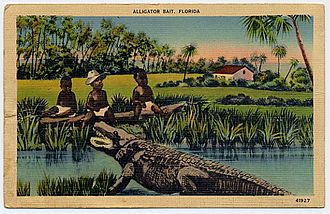This is an old revision of this page, as edited by Urve (talk | contribs) at 12:47, 2 September 2022 (link). The present address (URL) is a permanent link to this revision, which may differ significantly from the current revision.
Revision as of 12:47, 2 September 2022 by Urve (talk | contribs) (link)(diff) ← Previous revision | Latest revision (diff) | Newer revision → (diff) Purported historical practice
Both during and after the period of legal chattel slavery in the United States, black children were purportedly used as bait for alligators. In a wide array of media – including newspaper reports, songs, sheet music, and visual art – black children were frequently depicted luring alligators, though the practice's existence has not been proven. In contemporary American slang, alligator bait is a racial slur, and the practice remains in the cultural consciousness.
Origins
The details of identifying black children as alligator bait is unknown, but it may be a consequence of earlier associations of African crocodiles – a relative of American alligators – with Africa and its people. American alligators largely live in the swamplands of the South, which were one place people escaping enslavement hid to evade capture. According to popular legend, enslaved people who disappeared in swamps may have been killed by alligators; children were understood as particularly vulnerable to attacks by alligators, and that identification may have evolved into the bait image.
The image is a subtype of the racist pickaninny caricature and stereotype of black children, where they were represented as almost unhuman, filthy, and unlovable.
Popular imagination
In the American popular imagination, both during and after legal slavery, black children were commonly used as bait for alligators, the apex predator of American cultural life. Drawings of black children luring alligators were printed by companies like Underwood & Underwood on postcards, cigar boxes, sheet music covers, and in paintings. Several stories were printed in American newspapers about black children being used to lure alligators. Due to the popularity of the idea, letter openers were manufactured in designs resembling alligators, some of which came equipped with small replicas of black children's heads to be placed in the alligator's mouth. The sheet music drawings were almost purely symbolic; the images of black children being hunted by alligators were not represented in almost any corresponding music, though some songs (without the iconography) did have alligator bait as a component. In general, the drawings reinforced the racist belief that black people were victims to nature.
The concept also existed during the period of British rule over Sri Lanka; Sri Lankan children were said to have been used as bait for crocodiles, and several newspapers published stories and drawings of the purported practice.
Historical accuracy and contemporary culture
In May 2013, Franklin Hughes of the Jim Crow Museum of Racist Memorabilia determined that due to the number of periodicals which mention the use of black children as bait for alligators, it likely occurred, though it was not widespread or became a normal practice. Four years later, Hughes revisited the subject and analyzed the sources he used – stories from the Roanoke Times (1890), Washington Times (1908), and Oakland Tribune (1923) – and located others, including newspaper accounts and books. Though he found that Time magazine issued a rebuttal to the Oakland Tribune article, for example, he did not believe the rebuttal disproved the story. He reiterated his earlier conclusion that the practice, though rare, occurred. A Snopes article from 2017 was unable to prove or disprove that the practice occurred; Patricia Turner, a historian on black folklore and the alligator bait cultural phenomenon, told Snopes it likely did not happen.
In American slang, alligator bait (or 'gator bait) is a chiefly Southern slur aimed at black people, particularly children, though it also has currency in the North; the term implies that the target is worthless and expendable. The image of black children being put in peril to lure alligators remains.
References
Citations
- ^ Dean 2000, p. 33.
- Fulton 2006, pp. 127–128.
- Dean 2000, p. 22.
- Finley 2019, p. 18.
- Dean 2000, pp. 22–23.
- Tuck 2009, p. 417.
- ^ Hughes 2013.
- Dean 2000, p. 23.
- Pearson 2021, pp. 32–33.
- Cox 2010, p. 207.
- de Silva & Somaweera 2015, p. 6806.
- ^ Hughes 2017.
- Emery 2017.
- Herbst 1997, p. 8.
- Hinton 2009, pp. 101, 103.
Bibliography
- Cox, Nicole C. (2010). "Selling seduction: Women and feminine nature in 1920s Florida advertising". Florida Historical Quarterly. 89 (2): 186–209.
- Dean, Carolyn (2000). "Boys and girls and 'boys': Popular depictions of African-American children and childlike adults in the United States, 1850–1930". Journal of American and Comparative Cultures. 23 (3): 17–35. doi:10.1111/j.1537-4726.2000.2303_17.x.
- Finley, Cheryl (2019). "Photography and the archive". Critical Arts. 33 (6): 8–23. doi:10.1080/02560046.2019.1695868.
- Fulton, DoVeanna S. (2006). Speaking power: Black feminist orality in women's narratives of slavery. State University of New York Press.
- Emery, David (June 9, 2017). "Were black children used as alligator bait in the American South?". Snopes. Retrieved September 2, 2022.
- Herbst, Philip H. (1997). "Alligator bait". The color of words: An encyclopedic dictionary of ethnic bias in the United States. Intercultural Press. p. 8.
- Hinton, KaaVonia (2009). Sharon M. Draper: Embracing literacy. Scarecrow Press.
- Hughes, Franklin (May 2013). "Alligator bait". Jim Crow Museum. Ferris State University. Retrieved September 2, 2022.
- Hughes, Franklin (June 2017). "Alligator bait revisited". Jim Crow Museum. Ferris State University. Retrieved September 2, 2022.
- Pearson, Erin (2021). "Consuming monsters: Hungry animals in the discourse on slavery". Arizona Quarterly. 77 (2): 25–53. doi:10.1353/arq.2021.0009.
- de Silva, Anslem; Somaweera, Ruchira (26 January 2015). "Were human babies used as bait in crocodile hunts in colonial Sri Lanka?". Journal of Threatened Taxa. 7 (1): 6805–6809. doi:10.11609/jott.o4161.6805-9.
- Tuck, Eve (2009). "Suspending damage: A letter to communities". Harvard Educational Review. 79 (3): 409–428. doi:10.17763/haer.79.3.n0016675661t3n15.